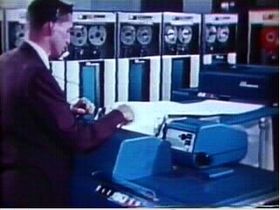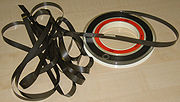
IBM 729
Encyclopedia


Magnetic tape
Magnetic tape is a medium for magnetic recording, made of a thin magnetizable coating on a long, narrow strip of plastic. It was developed in Germany, based on magnetic wire recording. Devices that record and play back audio and video using magnetic tape are tape recorders and video tape recorders...
mass storage system from the late 1950s through the mid 1960s. Part of the IBM 7 track
IBM 7 Track
IBM's first magnetic tape data storage devices, introduced in 1952, use what is now generally known as 7 track tape. The magnetic tape is 1/2" wide and there are 6 data tracks plus 1 parity track for a total of 7 parallel tracks that span the length of the tape...
family of tape units, it was used on late 700, most 7000
IBM 700/7000 series
The IBM 700/7000 series was a series of large-scale computer systems made by IBM through the 1950s and early 1960s. The series included several different, incompatible processor architectures. The 700s used vacuum tube logic and were made obsolete by the introduction of the transistorized 7000s...
and many 1400
IBM 1400 series
The IBM 1400 series were second generation mid-range business decimal computers that IBM sold in the early 1960s. They could be operated as an independent system, in conjunction with IBM punched card equipment, or as auxiliary equipment to other computer systems.1400-series machines stored...
series computers. Like its predecessor, the IBM 727
IBM 727
The IBM 727 Magnetic Tape Unit was announced for the IBM 701 and IBM 702 on September 25, 1953. It became IBM's standard tape drive for their early vacuum tube era computer systems. Later vacuum tube machines and first-generation transistor computers used the IBM 729-series tape drive...
and many successors, the 729 used 1/2 inch (12.7 mm) magnetic tape
Magnetic tape
Magnetic tape is a medium for magnetic recording, made of a thin magnetizable coating on a long, narrow strip of plastic. It was developed in Germany, based on magnetic wire recording. Devices that record and play back audio and video using magnetic tape are tape recorders and video tape recorders...
up to 2400 feet (730 m) long wound on reels up to 10½ inch (267 mm) diameter. To allow rapid tape acceleration, long vacuum columns were placed between the tape reels and the read/write heads
Tape head
A tape head is a type of transducer used in tape recorders to convert electrical signals to magnetic fluctuations and vice versa.-Principles of operation:...
.
Data format
The tape had seven parallel tracksIBM 7 Track
IBM's first magnetic tape data storage devices, introduced in 1952, use what is now generally known as 7 track tape. The magnetic tape is 1/2" wide and there are 6 data tracks plus 1 parity track for a total of 7 parallel tracks that span the length of the tape...
, six for data and one to maintain parity
Parity bit
A parity bit is a bit that is added to ensure that the number of bits with the value one in a set of bits is even or odd. Parity bits are used as the simplest form of error detecting code....
. Tapes with character data (BCD) were recorded in even parity. Binary tapes used odd parity. (709 manual p. 20) Aluminum strips were glued several feet from the ends of the tape to serve as logical beginning and end of tape markers. Write protection
Write protection
Write protection is any physical mechanism that prevents modification or erasure of valuable data on a device. Most commercial software, audio and video is sold pre-protected.-Examples:...
was provided by a removable plastic ring in the back of the tape reel. A 3/4 inch gap between records allowed the mechanism enough time to stop the tape. Initial tape speed was 75 inches per second (2.95 m/s) and recording density was 200 characters per inch, giving a transfer speed of 120 kbit/s. Later 729 models supported 556 and 800 characters/inch (transfer speed 480 kbit/s). At 200 characters per inch, a single 2400 foot tape could store the equivalent of some 50,000 punched card
Punched card
A punched card, punch card, IBM card, or Hollerith card is a piece of stiff paper that contains digital information represented by the presence or absence of holes in predefined positions...
s (about 4,000,000 six-bit bytes, or 3 MByte).
The 729 series was superseded by 9 track tape drives introduced with the IBM System/360.
Trivia
In early development, the prototype 729 had two status lights labeled Select and Idle. One day a vice president visited the lab and noticing this told the Engineers "That is not acceptable! IBM machines are NEVER idle!" The labels on the lights were quickly changed to Select and Ready.In 2008, an IBM 729 Mark 5 tape drive at the Australian Computer Museum Society was being pressed into service to read 173 data tapes from the Project Apollo
Project Apollo
The Apollo program was the spaceflight effort carried out by the United States' National Aeronautics and Space Administration , that landed the first humans on Earth's Moon. Conceived during the Presidency of Dwight D. Eisenhower, Apollo began in earnest after President John F...
lunar missions, once thought lost, that were recently found. http://www.abc.net.au/news/stories/2008/11/10/2415393.htm
As of 2009, the Computer History Museum
Computer History Museum
The Computer History Museum is a museum established in 1996 in Mountain View, California, USA. The Museum is dedicated to preserving and presenting the stories and artifacts of the information age, and exploring the computing revolution and its impact on our lives.-History:The museum's origins...
has working IBM 729 tape drives attached to their working IBM 1401
IBM 1401
The IBM 1401 was a variable wordlength decimal computer that was announced by IBM on October 5, 1959. The first member of the highly successful IBM 1400 series, it was aimed at replacing electromechanical unit record equipment for processing data stored on punched cards...
system (and is interested in reading 7-track tapes from the public). http://ed-thelen.org/1401Project/1401RestorationPage.html
729 I
The IBM 729 I was introduced for the IBM 709IBM 709
The IBM 709 was an early computer system introduced by IBM in August, 1958. It was an improved version of the IBM 704 and the second member of the IBM 700/7000 series of scientific computers....
and IBM 705 III computers, looked identical to the IBM 727
IBM 727
The IBM 727 Magnetic Tape Unit was announced for the IBM 701 and IBM 702 on September 25, 1953. It became IBM's standard tape drive for their early vacuum tube era computer systems. Later vacuum tube machines and first-generation transistor computers used the IBM 729-series tape drive...
, and used vacuum tube
Vacuum tube
In electronics, a vacuum tube, electron tube , or thermionic valve , reduced to simply "tube" or "valve" in everyday parlance, is a device that relies on the flow of electric current through a vacuum...
s. The main improvement was the use of a dual gap head permitting write verify.
729 II
The IBM 729 II was introduced for the IBM 7000 series computers, introducing a new cabinet style and transistorTransistor
A transistor is a semiconductor device used to amplify and switch electronic signals and power. It is composed of a semiconductor material with at least three terminals for connection to an external circuit. A voltage or current applied to one pair of the transistor's terminals changes the current...
ized circuitry. Supported dual density (200, 556).
729 III
High speed (112.5 in/s) single density (556).
External links
- Bitsavers.org Magnetic Tape Equipment manuals (PDF files)

